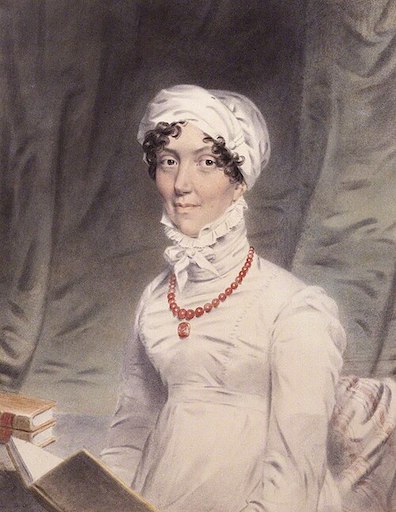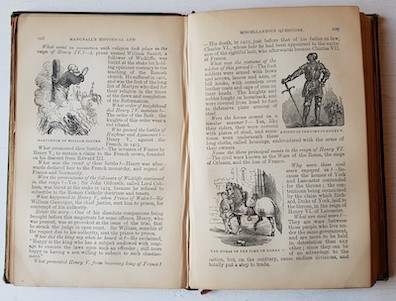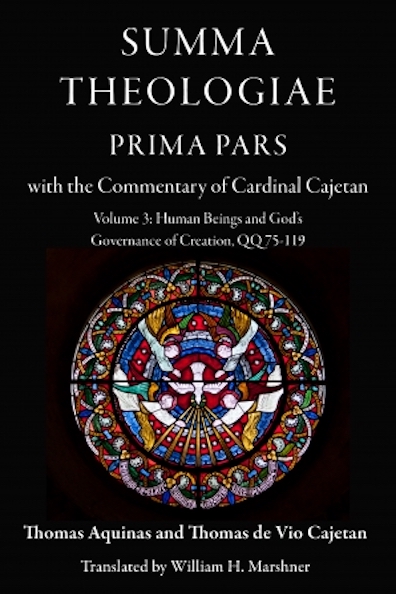Joyce told Frank Budgen that this was his favorite chapter, a
preference which says much about its quality but may also
reflect its having stemmed very directly from his educational
training. Catholic catechisms indoctrinate young people in the
tenets of their new faith via a long series of loaded
questions and definitive answers, and Joyce had to memorize
two of them before his tenth birthday. They are dull,
elementary exercises, but in Joyce they whetted an appetite
for more sophisticated question-and-answer discourses like
Thomas Aquinas's Summa Theologica (aka Summa
Theologiae) and Summa contra Gentiles,
philosophical works which break down every important aspect of
Catholic teaching into categories, subcategories, and
subsubcategories, state the correct position on a given
subject, consider the objections that can be made to it, and
counter them with detailed replies. Joyce became a devotee. In
Scylla and Charybdis Stephen refers to "Saint
Thomas...whose gorbellied works I enjoy reading in the
original," and later in the chapter Mulligan mocks him for it:
"I called upon the bard Kinch at his summer residence in upper
Mecklenburgh street and found him deep in the study of the Summa
contra Gentiles in the company of two gonorrheal ladies,
Fresh Nelly and Rosalie, the coalquay whore."
Although these Catholic rational habits clearly inform
Joyce's method, Ithaca pointedly rejects the
otherworldly premises of Catholicism in several allusions to
Dante's Divine Comedy, and instead takes a
quasi-scientific approach to very earthly subject matters. It
makes sense, then, that in addition to his religious
inspirations Joyce had a secular catechism in mind. Citing the
work of two other scholars, A. Walton Litz observes (Critical
Essays, 394) that the chapter is clearly indebted to
Richmal Mangnall's Historical and Miscellaneous Questions,
an encyclopedia-like textbook of history, biography, and
science "for the use of young people." First published in
1798, this durable educational staple went through more than
one hundred editions throughout the course of the 19th
century. In part 1 of A Portrait of the Artist, as
Stephen works up his courage to tell the rector about his
unjust punishment, he thinks, "A thing like that had been done
before by somebody in history, by some great person whose head
was in the books of history. And the rector would declare that
he had been wrongly punished because the senate and the Roman
people always declared that the men who did that had been
wrongly punished. Those were the great men whose names were in
Richmal Magnall’s Questions."
The Questions take children's brief naive queries and
flood them with information. Litz quotes this one:
What are comets?
Luminous and opaque bodies, whose motions
are in different directions, and the orbits they describe very
extensive; they have long translucent tails of light turned
from the sun: the great swiftness of their motion in the
neighbourhood of the sun, is the reason they appear to us for
such a short time: and the great length of time they are in
appearing again is occasioned by the extent and eccentricity
of their orbits or paths in the heavens.
This professorial sentence could almost be mistaken for one
of Joyce's in Ithaca. "There can be no doubt," Litz
remarks, that Mangnall's work "was a primary source for
Joyce's
'mathematico-astronomico-physico-mechanico-geometrico-chemico
sublimation of Bloom and Stephen'. To the modern adult reader
it is filled with unconscious humour and grotesque
distortions, but to the young Joyce it must have shimmered
with the poetic magic of unfamiliar names and mysterious words
(such as gnomon and simony)" (394). Running across such words,
and running to a dictionary to look them up, is one of the
great pleasures of reading Ithaca.
Both the church's theological discourses and Mangnall's
historical and scientific tome must have appealed to Joyce's
love of precise language and orderly rational categories, but
to adopt their stolidly straightforward industriousness would
have been intolerable. He found antidotes to the catechism's
stultifying quality in playful caprices, unpredictable
digressions, wry wit, and outright jokes. Ithaca is a
sham catechism—pseudo-scientific, rationality on laughing gas.
No less than any other late chapter in Ulysses, it is
animated by an archly parodic spirit. Litz floats the
interesting notion that it approaches "self-parody" (390, 395)
by aping the author's own Jesuitical intellectual habits.
There is a kind of escalatory logic to this. Cyclops
mocks patriotic Irish male blather and Nausicaa mocks
women's sentimental fiction. Oxen of the Sun sends up
ten centuries of English literary prose, Circe
explodes drama from the inside, and in Eumaeus the
keys to the car are handed over to someone as lacking in literary
skill as the novel's protagonist. After all this raising
of stakes, why not shoot the moon by mocking the author
himself?
But for all its self-referential hyper-rationality, Ithaca
never abandons the spirit of naive openness that catechisms
seek to foster in children's malleable minds, and it lays out
its story in an reassuringly straightforward way. Narrative
movement is conveyed through five clearly defined scenes.
First Stephen and Bloom walk from the quays to Eccles Street,
trying out a wide range of intellectual topics. Then a second
long conversation—nearly half the chapter—is conducted in the
kitchen as Bloom prepares and serves cocoa. More conversation
occurs after the two men leave the house by the back door and
stand in the garden under the stars. After Stephen leaves, a
fourth section of the chapter follows Bloom as he reenters the
house and spends some time alone in the parlor. Finally Bloom
is in his bedroom, putting away clothes, climbing into bed
with Molly, thinking about her as she sleeps, and engaging in
conversation with her when she wakes up. In his early
typescript drafts of the chapter, Joyce named these five
scenes: "street," "kitchen," "garden," "parlour," "bedroom"
(Litz, 398).
Ithaca delights in little logical puzzles that twist
readers' brains into pretzels, but a greater part of its
energy is devoted to the more straightforward business of
cataloguing things: topics of conversation, sequences of
actions, contents of rooms, contents of bookshelves, contents
of desk drawers, articles of clothing, mechanics of water
delivery, properties of water, astronomical phenomena,
characteristics of penises, places in Ireland, places abroad,
financial assets, credits and debits, daydreams of wealth,
moneymaking schemes, events of the past day, plans for the
future, possible bad ends to life, unsatisfactory conditions
of embodiment, unsatisfactory conditions of marriage, reasons
for divorcing, reasons for remaining married, strategies for
achieving equanimity, stages of sexual attraction, things
never quite understood—and on and on. These lists, some of
them obsessively long, feel as comprehensive and as
exhaustively detailed as Aquinas's analysis of theological
problems, and they create a sense of epic scope not unlike the
catalogues in Homer's Iliad.
But it is the Odyssey that Joyce's artistic
architecture most overtly invokes, and as in all the other
chapters readers must think about how to respond to the
invitation. How little or how much of the epic's violent
climax is echoed in the novel's story of coming home at the
end of a humdrum day? How much or little does Joyce's everyman
protagonist resemble Homer's extraordinary hero? How broadly
or minutely, and how often or rarely, are intertextual
connections insinuated? Joyce drops some very precise
reminders of Homer's episode into his own: Stephen and Bloom
constitute a "duumvirate" as they walk to
the house on Eccles Street, Bloom employs "A
stratagem" to get into it, Bloom thinks of a "preceding
series" of 24 men who came before Blazes Boylan, and he
asks "What retribution, if any" should redress the violation
of his matrimonial bed. But the answer to this
question—"Assassination, never, as two wrongs did not make one
right. Duel by combat, no. Divorce, not now...."—makes clear
that modern Ireland is not archaic Greece, poor Bloom is not
mighty Odysseus, and pacifist Joyce is not bloodsoaked
Homer.
Still, it seems certain that Joyce did not intend only faint
ironic echoes of Homer's rousing climax. Ithaca is
about regaining control—not through acts of savage violence,
as in the Odyssey, but through mental mastery of
life's insufficiencies. Bloom's efforts to achieve
"equanimity" about a crisis in his marriage are as heroic in
their small way as Odysseus's efforts to drive rival males out
of his palace, and the chapter's serenely detached prose
presents many other ways in which he rides out waves of worry,
distrust, insecurity, hostility, jealousy, and sorrow. Turning
on a tap elicits gratitude and wonder for the presence of
water. Failing to have bet on a winning horse brings not
disappointment but calm reflection. A viciously antisemitic
song about broken windows prompts him only to reflect that his
kitchen window remains unbroken. Intellectual frustrations
with Molly end in deep physical satisfaction as he lies
nestled in her backside. Fantastical dreams of sudden wealth
help him get to sleep at night. Visions of a beautifully
furnished house in the suburbs provide a mental landscape of
fulfillment beyond each day's economic striving, just like the
one that drives Odysseus on from island to island, back home
to Ithaca.
If this response to the chapter is on target, then its
strange pairing of epic triumph with schoolboy
instruction—Joyce called it the "ugly ducking" of the novel—is
not an awkward mismatch but a metaphysical conceit worthy of
John Donne. All of Ulysses allegorizes Homer's epic as
a journey of the human mind. Ithaca consummates this
reinterpretation, ending the saga of sadness, alienation, and
longing on a note of intellectual mastery.






